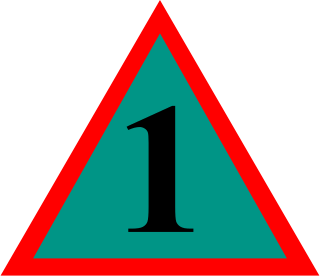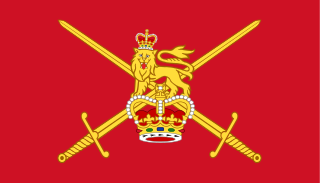
The 1st Infantry Division is a combined arms division of the United States Army, and is the oldest continuously serving division in the Regular Army. It has seen continuous service since its organization in 1917 during World War I. It was officially nicknamed "The Big Red One" after its shoulder patch and is also nicknamed "The Fighting First." The division has also received troop monikers of "The Big Dead One" and "The Bloody First" as puns on the respective officially sanctioned nicknames. It is currently based at Fort Riley, Kansas.

The VII Army Corps of the United States Army was one of the two principal corps of the United States Army Europe during the Cold War. Activated in 1918 for World War I, it was reactivated for World War II and again during the Cold War. During both World War II and the Cold War it was subordinate to the Seventh Army, or USAREUR and was headquartered at Kelley Barracks in Stuttgart, West Germany, from 1951 until it was redeployed to the US after significant success in the Gulf War in 1991, then inactivated in 1992.

The Irish Army, known simply as the Army, is the land component of the Defence Forces of Ireland. Approximately 7,300 people served in the Irish Army on a permanent basis as of May 2016, and there were 1,600 active reservists, divided into two geographically organised brigades. By late September 2020, this had reduced to 6,878 permanent army personnel.

160th (Welsh) Brigade or Brigâd 160 (Cymru), is a regional brigade of the British Army that has been in existence since 1908, and saw service during both the First and the Second World Wars, as part of the 53rd (Welsh) Infantry Division. It is a regional command responsible for all of Wales. The Brigade is also regionally aligned with the Eastern European and Central Asian regions as part of defence engagement.

The Royal Gurkha Rifles (RGR) is a rifle regiment of the British Army, forming part of the Brigade of Gurkhas. Unlike other regiments in the British Army, RGR soldiers are recruited from Nepal, which is neither a dependent territory of the United Kingdom nor a member of the Commonwealth.
The Rifles is an infantry regiment of the British Army. Formed in 2007, it consists of four Regular battalions and three Reserve battalions, plus a number of companies in other Army Reserve battalions. Each battalion of The Rifles was formerly an individual battalion of one of the two large regiments of the Light Division. Since formation the regiment has been involved in combat operations, first in the later stages of the Iraq War and in the War in Afghanistan.

The 1st Armoured Infantry Brigade was an infantry brigade of the British Army with a long history including service during both the First and the Second World Wars. It was based at Tidworth Camp. Previously, it has been designated 1st (Guards) Brigade, 1st Infantry Brigade, 1st Mechanised Brigade, and under the initial Army 2020 reforms assumed the title of 1st Armoured Infantry Brigade. Under the Future Soldier programme, the brigade merged with the 1st Artillery Brigade to form the 1st Deep Recce Strike Brigade Combat Team.

The 11th Security Force Assistance Brigade is a brigade of the British Army which is intended to train and assist foreign forces. In 2021, under the Future Army changes, the brigade was redesignated, formerly being the 11th Infantry Brigade & HQ South East. Prior to the Army 2020 changes in 2013, the brigade was temporarily activated for deployment to Afghanistan, and before that engaged during the two World Wars.
The 19th Brigade is an Army Reserve brigade of the British Army. As the 19th Infantry Brigade it fought in the First and Second world wars.

The Infantry Corps (INF) is the largest component of the Irish Army. Infantry soldiers are regarded as operational troops who must be prepared for tactical deployment in any location at short notice. In wartime, this means that they will be among the front line troops in the defence of the State. In peacetime however they can be seen daily performing operational duties in Aid to the Civil Power (ATCP) such as providing escorts to cash, prisoner or explosive shipments, patrols of vital state installations and border patrols, including check points.

The 27th Infantry Battalion is one of the seven infantry battalions of the Irish Army. The battalion was established on 1 September 1973 and forms part of the 2nd Brigade. The Battalion Headquarters is at Aiken Barracks, in Dundalk, County Louth.

The 1st Brigade is a brigade of the Irish Army. The brigade, which was known as 1st (Southern) Brigade until the 2012 reorganisation of the army, has its headquarters in Collins Barracks in Cork. The 1st Brigade is responsible for military operations in the south of Ireland. Its area of responsibility includes the counties of Galway, Offaly, Laois, Carlow, Kilkenny, Wexford, Waterford, Cork, Kerry, Limerick and Tipperary.
The 4th Military Intelligence Battalion is a military intelligence unit of the British Army's Intelligence Corps, which provides close intelligence support to the headquarters for the only warfighting division in the army.

The structure of the British Army of the United Kingdom (UK) is currently being reorganised to the Future Soldier structure. Due to these reforms taking place gradually, it is likely that some areas will not be fully complete. The British Army is commanded by the Chief of the General Staff (CGS), with Army Headquarters which is located in Andover, Hampshire. Subordinate to that post, there is a Commander Field Army, and a personnel and UK operations command, Home Command.

The Defence Forces Training Centre (DFTC) is the principal training centre for the Irish Army and other branches of the Irish Defence Forces, headquartered at the Curragh Camp that serves to provide education and training to recruits and officers. The DFTC also encompasses Glen of Imaal in County Wicklow which is the primary artillery and anti-tank firing range for the army. It primarily comprises the Military College, with various schools, alongside additional specialised schools. It also hosts some specialised army units. DFTC is home to 2,000 military personnel.
This article represents the structure of the Irish Defence Forces as of May 2020:
The 4th Infantry Battalion was an Infantry Battalion of the Irish Army from 1923 to 2012 based out of Collins Barracks, Cork. It was one of the oldest units of the Irish Army before its disbandment.

The Armed forces in Wales refers to military bases and organisation in Wales or associated with Wales. This includes servicemen and women from Wales and Welsh regiments and brigades of the British Armed Forces.

The 5th Infantry Battalion was an Infantry Battalion of the Irish Army from 1923 to its disbanding in 2012.

The 4th Brigade , also known as 4th (Western) Brigade was a Brigade of the Irish Army headquartered in Custume Barracks in Athlone. It was disbanded in 2012 during a reorganisation of the Irish Defence Forces.

















